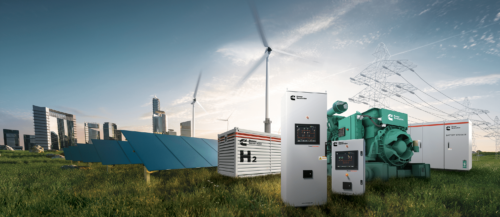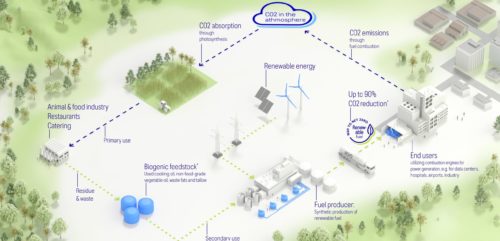Your questions answered: Power generation and the critical role biogas plays in the energy landscape
In this webcast, attendees learned about biogas as a main or backup fuel, biogas distributed generation characteristics and resiliency and renewable distributed generation.
As we move along the path to net zero, combined heat and power (CHP) continues to be a vital technology to cleanly and efficiently supplement daytime power needs and support utility grid operations. With high-efficiency and low-net CO2 emissions, renewable biogas is an overlooked resource whose time has come. This webinar, “Power Generation: The Critical Role Biogas Plays in the Energy Landscape,” which originally aired on Nov. 15, 2023, helped attendees learn about biogas as a main or backup fuel, biogas distributed generation characteristics and resiliency and renewable distributed generation.
The speakers were Augusto de Miguel, senior sales manager LATAM, Rolls-Royce Solutions America, and Juan Matson, senior sales manager, gas power systems and microgrids, Rolls-Royce Solutions America.
Additional questions were answered by Matson.
Question: Does biogas power generation get scheduled for maintenance when hydropower is up and running during spring runoff?
Answer: Biogas systems based on RECIPs and based on the different OEMs have their own maintenance routines (MRs). Typically, those MRs will, at minimum, be three main levels: periodic, top-end and O-H. It all depends on, based on the actual running hours (R-Hs) of the genset, when each of these MRs fall into. Operators will want to coordinate the MRs during the most favorable periods to avoid loss of power or when the grid is at its best conditions.
Question: What is the approximate CapEx and OpEx for the gensets you are discussing ($ per MW and $ per MW-hour)? What is the timeframe from order to equipment delivery? Are there any supply chain issues?
Answer: Deliveries are based on power nodes. A general rule of thumb (RoT) is approximately 42 to 52 weeks (enclosed units) depending on the power nodes. The supply chain issues are improving (switchgear and microprocessors are among the most complicated). I personally think that providing an average CapEx and OpEx pricing can be misleading, but one can have an idea of a range between $450 and $950/kWe depending on the scope and below $16/MWh (this includes all routines and consumables) assuming max RH/Yr. These may change project to project and RHs (which is a huge influencer).
Question: Do you have any information as to the possible role of septage in biogas supply?
Answer: That’s not our area of focus, but I’ve seen papers tackling this type of study and yield contribution.
Question: What kind of pretreatment do you require for biogas before your engines to address the harsh biogas you discussed?
Answer: It depends on the feedstock and the quality of the gas yielded. We would typically use carbon activated filters. Also, we’ve seen some bioscrubbers.
Question: How do you account for or monitor humidity in the gas stream before the CHP?
Answer: Humidity sensors that can also (as added value) be implemented in our control panels. We’d need to monitor before the gas coolers and/or after the gas heater depending on which processes are in need.
Question: For electricity generation purposes, what about running the gas through a fuel cell rather than a CHP system? eRINs and electricity export value?
Answer: This can be done, but the prevailing factor in DG would still be CapEx and having technologies at scale.
Question: Does Rolls Royce supply just the gensets or complete systems? Are there commercial guarantees or warranties available?
Answer: We are a genset systems manufacturer, and either us or our distribution network integrates with local based balance of plant (BoP) like SCRs, OxyCats, SwGr, enclosures, gas cleaning systems, ab-chillers, EGHEs, JWHEs, etc.
Question: You talked about the differences between biogas and natural gas/other gaseous fuels. Can you talk about the differences in operating costs for a biogas engine/CHP system versus one on conventional fuel?
Answer: From our newest rollout perspective, our RECIP is FlexiFuel, and this possesses virtually marginal OpEx differences. The power nodes are the same for both natural gas and biogas. Only propane (HD5) and special gases have derating.
Question: What are the genset sizes (MW) available?
Answer: We are currently offering our Std power nodes 1 Mwe, 1.5 Mwe, 2 Mwe and 2.5 Mwe. These will remain or differ according to site conditions, gas quality and composition.
Question: Can the 25% H2 blend with natural gas be piped safely through existing pipelines?
Answer: Most of the T&D pipeline in Germany/Europe are indicting agreement around 20% in-the-mix (ItM). I understand that NA Gas T&D entities are currently investigating and studying the impacts of H2 in their network to define the optimum % ItM.
Question: How can biogas be competitive with natural gas?
Answer: The operational cost of the fuel is much lower. The PowerGen original equipment (OE) is virtually the same, and the added CapEx for digesting is mitigated by ITCs or PTCS and other programs.
Question: The Myanmar project was challenging. Can you elaborate more on the issues?
Answer: The gas was very dirty and needed lots of cleaning (due to tar), and the LHV was very low.
Question: How much more efficient are engines than boilers when using biogas for power generation?
Answer: We can’t compare two different processes, but by means of CHP, almost 50% of the input heat to the genset yields in free thermal power than can offset the actual boiler (whether it’s an electrical or gas) consumption.
Question: Do you generate any carbon credits by utilizing biogas for power generation?
Answer: Not us, per se, but the site operator that models their whole business case on different streams such as RECs, RFS-RINs, etc., does.
Question: Low speed and high speed were mentioned early on in the webcast. What are the slow and high speed, and why the two?
Answer: The speed was based on the RPM of the RECIPs. Low/medium speed have higher CapEx and more balance of plant, but the advantage of lower OpEx. But in the end, high speed is easily deployable, and one can manage OpEx schemes that can fit into the overall life cycle of the project. Another advantage with high speed is its adaptability to microgrids and lower load factors and grid-tied to off-grid operations. There’s more flexibility. The debate is always as to where the lines cross from the CapEx-OpEx perspective based on the expected life cycle of a given project.
Do you have experience and expertise with the topics mentioned in this content? You should consider contributing to our CFE Media editorial team and getting the recognition you and your company deserve. Click here to start this process.





